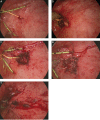Suprapubic transvesical laparoendoscopic single-site surgery for vesicovaginal fistula repair: a case report
- PMID: 23362433
- PMCID: PMC3557738
- DOI: 10.5114/wiitm.2011.30816
Suprapubic transvesical laparoendoscopic single-site surgery for vesicovaginal fistula repair: a case report
Abstract
Some minimally invasive techniques have been introduced to decrease morbidity related to standard laparoscopic procedures. One such approach is laparoendoscopic single-site surgery (LESS), which can also be applied for transvesical surgery. The aim of the study was to present our initial clinical experience of using this technique for transvesical vesicovaginal fistula (VVF) repair. In August 2011, we carried out the LESS repair of a 3-mm in diameter vesicovaginal fistula on a 72-year-old woman, who failed the conservative treatment with Foley placement. The procedure was performed transvesically (percutaneous intraluminal approach) with a single-port device (4-channel, TriPort+, Olympus Winter&IBE GMBH) via a 1.5-cm incision made 2 cm above the pubic symphysis. A standard 10-mm optic and straight laparoscopic instruments were used. The fistulous tract was dissected and partially excised. The bladder and vaginal wall defects were closed in two layers with running absorbable V-Loc (Covidien, Norwalk, CT, USA) suture. Ureteral catheters were left for 5 days and the Foley catheter for 14 days. The operative time was 170 min. The blood loss was minimal. No complications were observed. The postoperative period was uneventful. During a 6-month follow-up the patient reported no involuntary discharge of urine into the vagina. Diagnostic scans revealed no presence of VVF and laboratory examination results were all within the normal range. Although substantial development of the instruments and skills is needed, the transvesical LESS vesicovaginal fistula repair appeared to be feasible and safe. Nevertheless, further experience and observations are necessary.
Keywords: laparoendoscopic single-site surgery; minimally invasive surgery; vesicovaginal fistula.
Figures



References
-
- Urbanowicz W, Sulislawski J, Wolnicki M. Single incision laparoscopic surgery in children – a preliminary report. CEJ Urol. 2010;63:132–4.
-
- Michalik M, Orlowski M, Frask A, et al. LESS (laparo-endoscopic single-site surgery) right hemicolectomy. Videosurgery Miniinv. 2009;4:164–7.
-
- Ganpule A, Dhawan D, Kurien A, et al. Laparoendoscopic single-site donor nephrectomy: a single-center experience. Urology. 2009;74:1238–40. - PubMed
-
- Desai MM, Berger AK, Brandina R, et al. Laparoendoscopic single-site surgery: initial hundred patients. Urology. 2009;74:805–12. - PubMed
-
- Gettman M, White MW, Aron M, et al. Where do we really stand with LESS and NOTES? Eur Urol. 2011;59:231–4. - PubMed
Publication types
LinkOut - more resources
Full Text Sources
